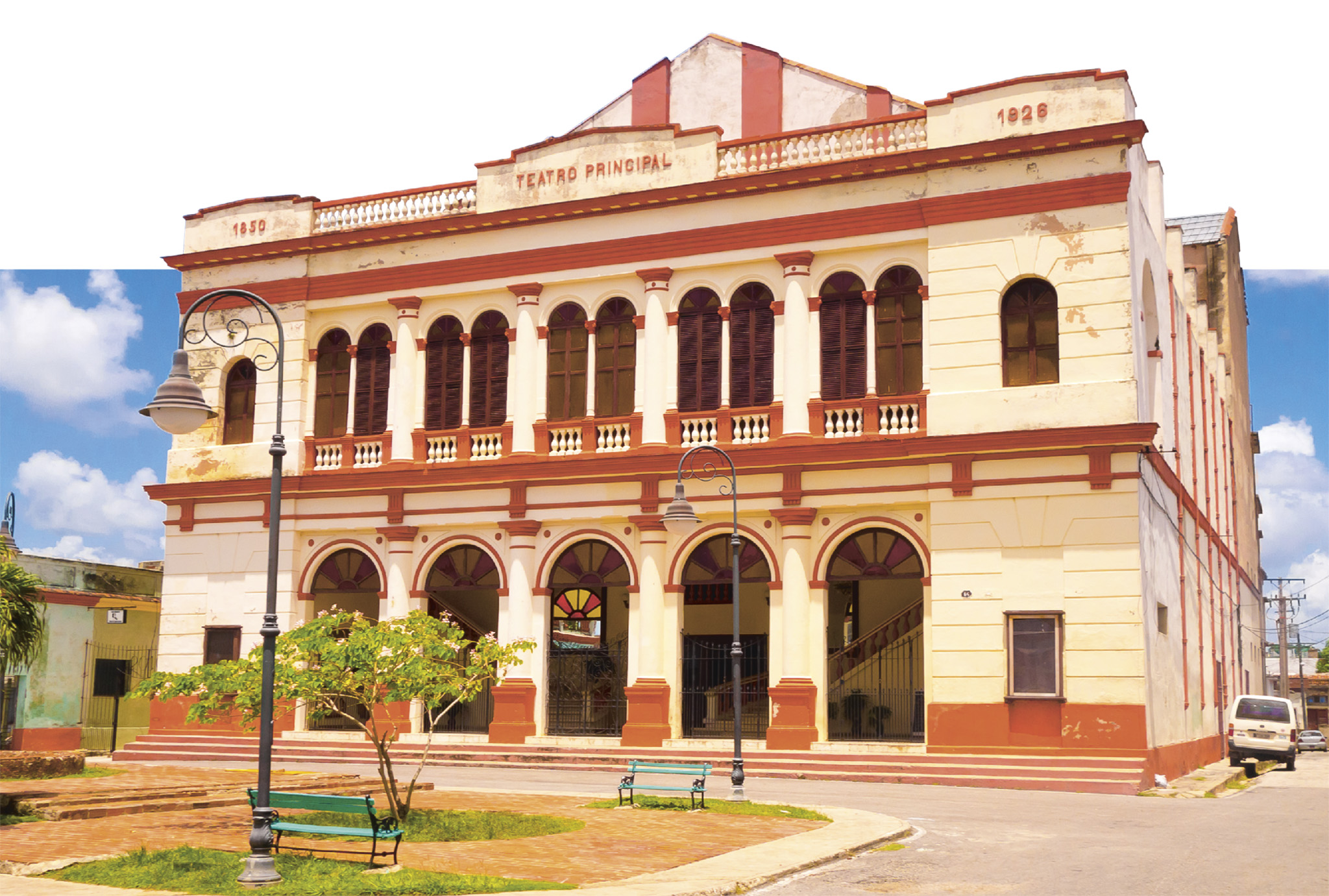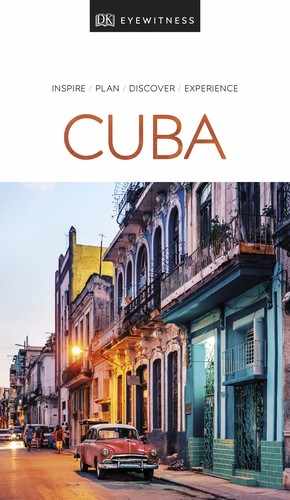This city, declared a UNESCO World Heritage Site in 2008, lies in the middle of a vast area of pastureland. It is nicknamed “the Legendary” for its traditions of heroism and patriotism as well as for its Neo-Classical architecture. The irregular, intricate street network that distinguishes Camagüey from other Cuban cities resulted from the need to protect itself from raids.

t The bustling Plaza de los Trabajadores square in the centre of Camagüey
Experience Central Cuba – East

n Double-tap image to read the labels
The former Plaza de Armas is dominated by an equestrian statue of Agramonte, a Cuban independence hero, sculpted by the Italian artist Salvatore Boemi and inaugurated by Amalia Simoni, Agramonte’s wife, in 1912. At the four corners of the square stand royal palms, planted in memory of a group of nationalists executed here in 1851. The palms are symbolic monuments to the rebels, as the Spanish would never have allowed real monuments to be built.
Buildings of interest on the square include the Casa de la Trova Patricio Ballagas – an 18th-century building with a courtyard – the Biblioteca Julio Antonio Mella and the cathedral. With its benches and shade from the palm trees, the square is a natural gathering point for the people of Camagüey. It is also a popular spot to see the town’s famous tinajones (clay pots).
Camagüey’s cathedral, dedicated to Our Lady of Candelaria, who is also the patron saint of the city, was designed by Manuel Saldaña and built in 1735. In 1777 a bell tower was added, but it collapsed a year later. Since then, the church has been through phases of reconstruction, taking on its present appearance in 1864. It now has a monumental façade surmounted by a pediment, and a bell tower crowned by a statue of Christ.

t The nave of the Catedral de Nuestra Señora de la Candelaria
Did You Know?
Camellos – Camagüey’s articulated buses – are called “camels” for their sunken hump.
Near Plaza de los Trabajadores, where a large ceiba tree marks the middle of the old town, is the former home of Ignacio Agramonte, the famous local patriot who died in battle in 1873 at the age of 31. His two-storey house dates from 1750 and has a beautiful inner courtyard with old tinajones.
Inside Agramonte’s former home, the museum displays documents concerning the war of independence, the hero’s personal belongings, such as his 36-calibre Colt revolver from 1851, and family furniture, including the piano of his wife, Amalia Simoni. Simoni was reputed to be one of the richest, most virtuous women in the city at the time.
A short walk away, you’ll find another famous home. At Calle Hermanos Aguero 58 is the Casa Natal de Nicolás Guillén, birthplace of Cuba’s poet laureate who was influenced by son and died in 1989.
The Tinajones
These romantic symbols of Camagüey can be seen everywhere you look – in parks and gardens and especially in the courtyards of the beautiful colonial houses that characterize the city. Tinajones are large jars, which may be as much as 2 m (6 ft) tall, made of clay from the nearby Sierra de Cubitas mountain range. The jars were introduced to the city by Catalonian immigrants in the early 1700s, and are still used today to collect rainwater and to store food.
The Iglesia de la Merced was built in 1601, but it was rebuilt from 1748 to 1756. It now has a Baroque façade with a central bell tower. Inside are striking, almost Art Nouveau-style murals. Most famous, however, is the Holy Sepulchre with an 18th-century statue of Christ by Mexican sculptor Juan Benítez Alfonso. It was cast from 23,000 silver coins collected from the faithful by Manuel Agüero, a citizen who, after his wife’s death in 1726, became a monk and devoted himself to restoring the church.

t The grand exterior of the Teatro Principal, famed for its ballet company
First opened in 1850 and rebuilt in 1926 after a devastating fire, this theatre is famous as the home of the Camagüey Ballet. Founded in 1967, it is one of the most highly regarded dance companies in Latin America.

t Pastel-coloured houses looking over a shopping street in the centre of Camagüey

Picture Perfect
Statue Subjects
Take a selfie with one of Martha Jiménez’s lifesize bronze figures, which are scattered around the city. The artist’s studio on Plaza del Carmen (www.martha-jimenez.es) overlooks Jiménez’s frieze of three seated women, entitled Chismosas (The Gossipers). Sit in the empty fourth chair and pose with the statue.
Laid out in 1732, this square is also known as Plaza del Padre Olallo, in honour of a priest who was beatified in 2008 because he dedicated his life to caring for the sick in the city’s hospital.
Today, the square is a quiet, picturesque spot, but also a gem of colonial architecture. Around it are 18th-century pastel buildings, several of which have been converted into restaurants.
A church and an old hospital in the Plaza San Juan de Dios are now the home of the Dirección Provincial de Patrimonio and the Oficina del Historiador de la Ciudad, a body that takes care of the province’s cultural heritage.
Despite its small size, the Iglesia de San Juan de Dios is one of the most interesting churches in Camagüey. It still has its original floors, ceiling and wooden choir, and, most importantly, the high altar with the Holy Trinity and an anthropomorphic representation of the Holy Ghost, the only one in Cuba. The church façade is simple and rigorously symmetrical.
The old hospital has had many roles in city life, including as a military infirmary, and, most recently, as the Instituto Tecnológico de la Salud (Technological Institute of Health). The square plan with two inner courtyards (clearly of mudéjar influence) was modelled on Baroque monasteries. The enclosure walls are thick and plain; in contrast the window grilles and wooden balustrades in the galleries are elegant and elaborate.
The only military building in town was the headquarters of the Spanish army cavalry in the 19th century. In 1905 it became a hotel, and since 1948 it has housed a large museum of the history, natural history and art of the city and province of Camagüey. The prestigious small art collection is second in the country only to that in the Museo de Bellas Artes in Havana, with three works by the famous Cuban artist Fidelio Ponce. Ponce’s works were unique at their time, depicting poverty and sadness in Batista’s Cuba in the 1930s. There is also a fine collection of books, including some manuscripts by the Canaries writer Silvestre de Balboa, author of Espejo de Paciencia, a 1608 poem regarded as the first literary work in Cuba.

t Cycling past the central fountain in the Parque Casino Campestre
The largest natural park in any Cuban city, the Casino was for a long time used for agricultural fairs, but it became a public park in the 19th century. Besides the many statues of patriots and illustrious figures from Camagüey and the rest of Cuba, the park also has a monument to the Seville pilots Barberán and Collar, who on 10 June 1933 made a historic transatlantic flight from Seville to Camagüey in 19 hours 11 minutes. The Hatibonico river flows through the park.
